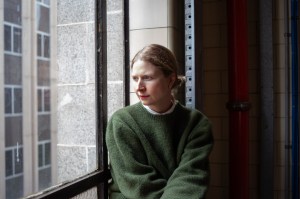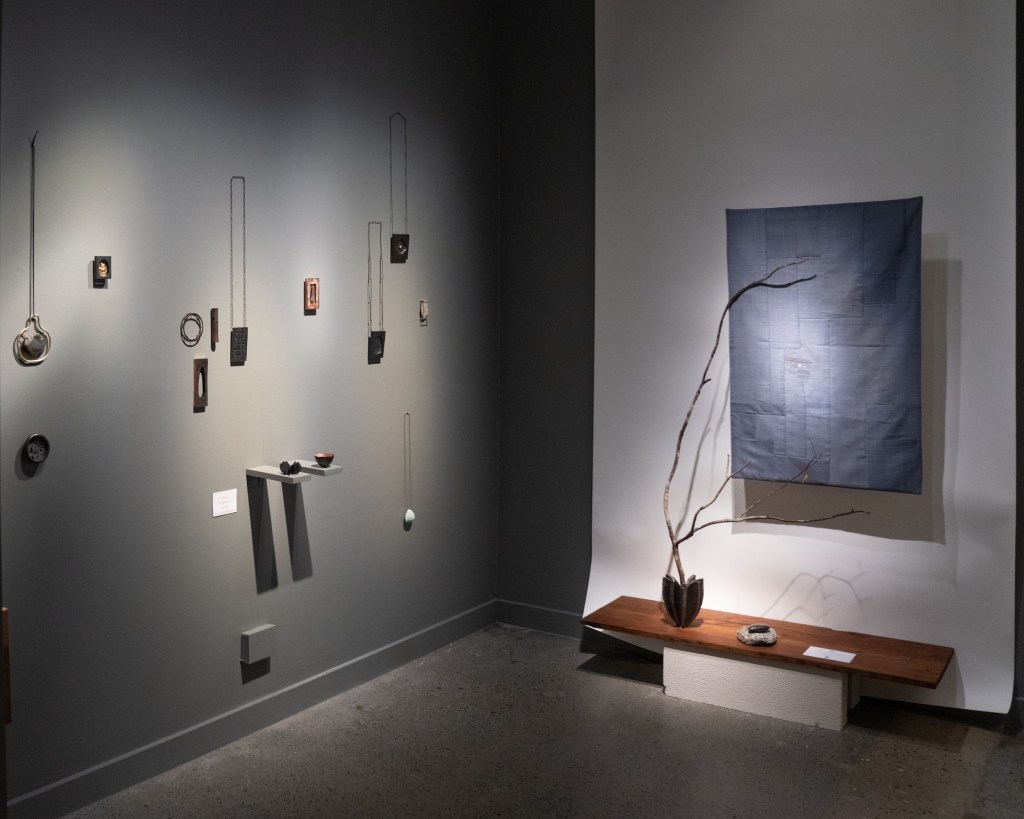From little things, big things grow
Putting the pedal to the metal – two exhibitions at Artisan in Bowen Hills explore large and small objects.

Less discernible edges brings Anna Varendorff’s practice home to Brisbane, where she trained and tested her first sculptural ideas. Her practice explores the “revolutionary capacity” of the handmade, the politics of labour, and feminism, particularly as a maker in metal.
The exhibition title describes the ethic that continues to forge her practice, which is now largely based in Melbourne and fuelled by international opportunities. It refers to her use of divergent materials and methods of making, which “move in and out like breath, from craft into the contemporary and conceptual”.

Varendorff works in metal, often creating rounded shapes as vessels that remain literally open-ended, completed by sticks and branches – an organic and rustic extension to a finely honed and burnished aesthetic.
The 11 works in the exhibition are anchored within the space by one of her large, freestanding Invertible vessels, its double U-shape secured with an echo of this U-shape in its base, holding branches that reach almost to the ceiling.
At the opening of the exhibition, Varendorff explained that it was “an emotional experience when I work with Artisan, because the first shows I had were with this organisation”.
“I was selected for Unleashed in 2006 (Artisan’s biennial exhibition of emerging practitioners), which helped to position me internationally,” she says.
You might like
“Without craft practice, thinking about materials and methods of making, intentions of making and the uniqueness of objects, we’re drowning in a capitalist system of ordinariness. The objects shown here at Artisan really carry us through life with more sensitivity than you would otherwise be able to access.”

Integral to Varendorff’s practice is fabrication, and she acknowledges the importance of others to the construction of objects seen in the exhibition, many of which more than one metre tall and, given their constituent metals (aluminium, stainless steel, brass) – heavy.
‘a rebuttal against the capitalist logic of endlessly increasing profit’
Her process requires communication between her knowledge of materials and techniques and the expertise of her community of collaborators. In making these objects she finds “a rebuttal against the capitalist logic of endlessly increasing profit … [and] for the magic and singularity of the object that emerges, the small variations in its surface from the handwork that was necessary to create it, and the glitches or beauty that are part of its character.”
Varendorff studied at Queensland College of Art and is part of a strong design cohort that emerged during the 1990s, fuelled at least in part by the profile of earlier practitioners (like Barbara Heath and Ari Athans), whose work forged new ground in the area of the sculptural handmade.
Varendorff went to Melbourne to study for a master of fine art degree in 2009, and now works between ACV Studio and her art practice, creating public art, sculpture, design and sometimes jewellery.
In the small object space is an exhibition of work by Mari Hirata, which carries significant personal weight in its exploration of Omamori, a Japanese concept that attributes supernatural power to talismans and amulets.
Subscribe for updates
Small precious objects echo the natural shapes of leaves, stones carry sound and tiny bowls are among handcrafted shapes that evoke snow, rain and forests, pointing to deeper and significant potential.
In the making of this exhibition, Hirata found resilience in the power of her artistry, saying: “I’m dealing with grief in this exhibition and it’s a universal human thing. People have reached out to share their own stories, which makes it all worth it.”

This final Artisan exhibition for 2025 is also their last at their King Street Gallery and follows the organisation’s assembly of a delegation to travel to Japan to showcase Queensland craft and design at Expo 2025 Osaka, embodying “the distinctive qualities that hero our organisation’s ambition for the state’s makers”.
Integral to this developing ambition is chief executive officer Carmel Haugh’s announcement of a new chapter for Artisan in its 55th year of operation. In her view, the future for Queensland craft and design is strong, amid an economic environment which has seen a changing environment that requires a level of re-strategisation.
“In January we will move premises,” says Haugh. “Our new infrastructure plan (yet to be unveiled) sees Artisan more closely aligned to Brisbane’s cultural precinct at South Bank. Our exhibition program will be run in collaborative partnerships with other galleries. I have nicknamed this new chapter, with details soon to be announced, ‘radical pragmatism’, and I believe that, as a result, we will grow audiences for the designer makers who are always central to our purpose.”
The first of these partnered exhibitions is Unleashed 2026, to open on August 1 at the Gold Coast’s HOTA, where audiences for the biennial showcase of emerging practitioners will be significantly increased.
“We are building on our legacy with renewed purpose,” says Haugh. “The talent and creative power of our makers is worthy of our even bigger vision in 2026.”
For career professionals such as Varendorff, whose work was assisted through Artisan’s Unleashed exhibition platform more than 20 years ago, the ongoing opportunities seeded by the organisation are essential to allow the handmade to continue to flourish and grow.
Anna Varendorff: less discernible edges, Artisan main gallery, Bowen Hills, until December 23; Mari Hirata: Omamori Artisan small object space, until December 23.

